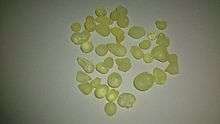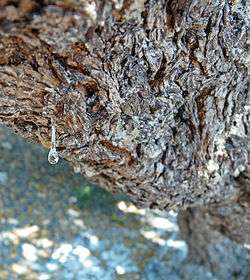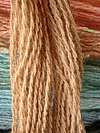Mastic (plant resin)


Mastic (Greek: Μαστίχα) is a resin obtained from the mastic tree (Pistacia lentiscus). In pharmacies and nature shops, it is called "Arabic gum" (not to be confused with gum arabic) and "Yemen gum". In Greece, it is known as the "tears of Chios," being traditionally produced on that Greek island, and, like other natural resins, is produced in "tears" or droplets.
Originally a sap, mastic is sun-dried into pieces of brittle, translucent resin. When chewed, the resin softens and becomes a bright white and opaque gum. The flavor is bitter at first, but after some chewing, it releases a refreshing, slightly pine or cedar-like flavor.
History
Mastic has been harvested for at least 2,500 years since Greek Antiquity. The word mastic is derived from Greek: μαστιχειν, translit. mastichein "to gnash the teeth", which is also the source of the English word masticate.[1]. The first mention of actual mastic 'tears' was by Hippocrates. Hippocrates used mastic for the prevention of digestive problems, colds and as a breath freshener. Roman emperors used mastic along with honey, pepper, and egg in the spiced wine conditum paradoxum. Under the Byzantine Empire, the trade of mastic was made the emperor's monopoly. In the Ottoman Empire, the sultan gathered the finest mastic crop to send it to his harem.
During the Ottoman rule of Chios, mastic was worth its weight in gold. The penalty for stealing mastic was execution by order of the sultan. In the Chios Massacre of 1822, the people of the Mastichochoria region were spared by the sultan to provide mastic to him and his harem. Sakız Adası, the Turkish name for the island of Chios, means "island of gum". The mastic villages are fortress-like, out of sight from the sea, surrounded by high walls and with no doors at street level, meaning that the villages were entered only by ladders) in order to protect the sap from invaders.
Although the liqueur is much younger, it is still tied up with Greek history. Digestive liqueurs, similar to Mastiha but made with grapes, were known as the Greek elixirs before the French Revolution.
The production of mastic was threatened by the Chios forest fire that destroyed some mastic groves in August 2012.
Cultivation
Producing the mastic resin is a whole-year process for the local growers. The harvest is known as kentos and takes place from the beginning of July to the beginning of October. First, the area around the trees is cleared and sprinkled with inert calcium carbonate. Then, every 4–5 days, 5–10 incisions are made in the bark of each tree to release the resin. As these clear drops hang from the tree, and sparkle in the sunlight, they are said to resemble crystalline teardrops; for this reason, the mastic resin is known as the "tears of Chios". It takes about 15–20 days for the first resin crystals to harden and fall to the ground. The farmers then collect the pieces of dry mastic and wash them in natural spring water, and spend most of the winter cleaning and separating the tears from the sand. This cleaning process is performed by hand and is regulated by the legislative framework of the Mastic Growers' Association. In addition to mastic, mastic oil is also produced.
Mastichochoria

At present, there are twenty-four mastichochoria, or mastic villages on the island of Chios, which have been dedicated to the cultivation and production of mastic since the Byzantine era. Mastic production in Chios is protected by a European Union protected designation of origin.
The island's mastic production is controlled by a co-operative. Founded in 1938, the Chios Gum Mastic Growers Association (Greek: Ένωση Μαστιχοπαραγωγών Χίου), abbreviated CGMGA, is a secondary cooperative organisation and acts as the collective representative organ of twenty primary cooperatives founded in the twenty-four mastic villages.[2] it has the exclusive management of natural Chios Mastiha in Greece and abroad.[3]
On 11 June 2016,[4] the Chios Mastic Museum opened its doors in Rachi. It offers a permanent exhibition about mastic production on the island, explaining its history and cultivation techniques as well as demonstrating its different uses today.[5]
Turkey
Traditionally there has also been limited production of mastic on the Çeşme peninsula, on the Turkish coast only eight nautical miles from Chios, with similar ecological conditions suitable for mastic production.[6] The Turkish Foundation for Combating Soil Erosion, for Reforestation and the Protection of Natural Habitats TEMA has been leading a project to protect the native mastic trees and to plant new ones in Çeşme peninsula to revive viable commercial production. As part of this project, which is expected to last through 2016, over 3,000 mastic tree saplings were planted between 2008 and October 2011 to over 368 acres (149 hectares) of dedicated farm land provided by the Izmir Institute of Technology.[7]
Uses
Medicinal
Mastic has been used as a medicine since antiquity and is still used in traditional folk medicine of the Middle East. In ancient Greece, it was given as a remedy for snakebite. The first-century Greek physician Pedanius Dioscorides mentions the healing properties of mastic in his book De Materia Medica. Hippocrates wrote that the mastic is good for prevention of digestive problems and colds, and Galenus suggested that mastic was useful for bronchitis and for improving the condition of the blood.
Mastic contains antioxidants and also has antibacterial and antifungal properties.[8] A University of Nottingham study published in The New England Journal of Medicine finds that mastic can cure peptic ulcers by killing Helicobacter pylori bacteria.[9] Other studies have indicated that mastic has only a modest ability to eliminate H. pylori but have also suggested that refining mastic by removing the polymer poly-β-myrcene may make the active components, particularly isomasticadienolic acid, more available and effective.[10]
One study found that high consumption of Chios mastic powder results in decreased levels of total serum cholesterol, LDL, total cholesterol/HDL ratio, lipoprotein (a), apolipoprotein A1, apolipoprotein B, ALT, AST, and GGT.[11] Mastic oil is widely used in the preparation of ointments for skin disorders and afflictions. In the past, it was also used in the manufacture of adhesive bandages.
Dental hygiene
Mastic may have some value in preventing tooth decay[12] and gingivitis[13] as well as chewing mastic reduces oral bacteria. In medieval times, mastic was highly valued by sultans' harems as a breath freshener and a tooth whitener. In India and Persia, mastic was used to fill dental cavities.
Culinary
Chios mastic is a known spice in the Eastern Mediterranean. It is commonly used for baking and cooking, adding its aroma to foodstuffs such as brioches, ice-cream and other desserts.[14] It is especially known to the Arabian cuisine, but recently mastic is also increasingly used in Japanese cooking.[15]
One of the earliest uses of mastic was as chewing gum; hence, the name. Mastic-flavored chewing gum is sold in Syria, Lebanon,[16] Turkey, and Greece. Mastic is used in ice cream, sauces, and seasoning in Lebanon. In Egypt, mastic is used in vegetable preserves, in jams that have a gummy consistency and in soups. In savoury dishes Egyptian chicken, duck, rabbit and fish recipes often call for mastic, usually paired with cardamom[17]. In Morocco, mastic is used in the preparation of smoked foods.
In Syria, mastic is added to booza.
In Turkey, mastic is widely used in desserts such as Turkish delight and dondurma, in puddings such as sütlaç, salep, tavuk göğsü, mamelika, and in soft drinks. Mastic syrup is added to Turkish coffee on the Aegean coast.
In the Maghreb countries, mastic is used mainly in cakes, sweets, and pastries and as a stabilizer in meringue and nougat.
In Greece, mastic is used in liqueurs such as Chios Mastiha, in a spoon sweet known as or "submarine" (Greek: υποβρύχιο, translit. ypovríchio), in beverages, chewing gum, sweets, desserts, breads and cheese. It is also used to stabilise Turkish delight and ice cream.
In religion
Some scholars identify the bakha mentioned in the Bible with the mastic plant. Bakha appears to be derived from Hebrew: בכא, weeping, and is thought to refer to the "tears" of resin secreted by the mastic plant.
Ancient Jewish halachic sources indicate suggest mastic as a treatment for bad breath: "Mastic is not chewed on shabbat. When [is it not permissible to chew mastic on shabbat]? When the intention is medicinal. If it is used for bad breath, it is permissible."[18]
Mastic is an essential ingredient of chrism, the holy oil used for anointing by the Orthodox Churches.
Other uses
Mastic is used in some varnishes. Mastic varnish was used to protect and preserve photographic negatives.[19] Mastic is also used in perfumes, cosmetics, soap, body oils, and body lotion. In ancient Egypt, mastic was used in embalming. In its hardened form, mastic can be used, like frankincense or Boswellia resin, to produce incense.
Imitations and substitutes
The rarity of mastic and the difficulty of its production make it expensive. As a result, imitations in the form of other resins appear in the market, sold as "mastic", such as Boswellia or gum arabic. Other trees, such as Pistacia palaestina, can also produce a resin similar to mastic. Yet other substances, such as pine tree resin and almond tree resin, are sometimes used in place of mastic.
See also
References
- ↑ "Mastic @ The EpicentreThe Epicentre". Theepicentre.com. Retrieved 2013-06-18.
- ↑ Belles, Christos (2005). Mastiha Island. Athens: Ellinika Gramatta Press. pp. 212–13. ISBN 978-960-89048-9-7.
- ↑ "Mastiha Growers Association". www.gummastic.gr. Retrieved 2016-06-20.
- ↑ Evgenia Choros. "Chios Mastic Museum Opened Its Doors on June 11th". Retrieved 2016-06-21.
- ↑ "The Chios Mastiha Museum". Retrieved 2016-06-21.
- ↑ Gönderen Burçin ÇOKUYSAL (1923-03-20). "ECOLOGIC EVALUATION OF Pistacia lentiscus (MASTIC) IN ÇEŞME PENINSULA". Burcincokuysal.blogspot.com. Retrieved 2013-06-18.
- ↑ TEMA Foundation. "Sakız Ağaçlarına Sevgi Aşılıyoruz Projesi'nde yeni bir dönem başlıyor". Retrieved 2014-06-06.
- ↑ Koutsoudaki C, Krsek M, Rodger A (October 2005). "Chemical composition and antibacterial activity of the essential oil and the gum of Pistacia lentiscus Var. chia". Journal of Agricultural and Food Chemistry. 53 (20): 7681–5. doi:10.1021/jf050639s. PMID 16190616.
- ↑ Huwez FU, Thirlwell D, Cockayne A, Ala'Aldeen DA (December 1998). "Mastic gum kills Helicobacter pylori". The New England Journal of Medicine. 339 (26): 1946. doi:10.1056/NEJM199812243392618. PMID 9874617.
- ↑ Paraschos S, Magiatis P, Mitakou S, et al. (February 2007). "In vitro and in vivo activities of Chios mastic gum extracts and constituents against Helicobacter pylori". Antimicrobial Agents and Chemotherapy. 51 (2): 551–9. doi:10.1128/AAC.00642-06. PMC 1797732. PMID 17116667.
- ↑ Triantafyllou, A.; Chaviaras, N.; Sergentanis, T. N.; Protopapa, E.; Tsaknis, J. (2007). "Chios mastic gum modulates serum biochemical parameters in a human population". Journal of Ethnopharmacology. 111 (1): 43–49. doi:10.1016/j.jep.2006.10.031. PMID 17150319.
- ↑ Aksoy A, Duran N, Koksal F (June 2006). "In vitro and in vivo antimicrobial effects of mastic chewing gum against Streptococcus mutans and mutans streptococci". Archives of Oral Biology. 51 (6): 476–81. doi:10.1016/j.archoralbio.2005.11.003. PMID 16343417.
- ↑ Takahashi K, Fukazawa M, Motohira H, Ochiai K, Nishikawa H, Miyata T (April 2003). "A pilot study on antiplaque effects of mastic chewing gum in the oral cavity". Journal of Periodontology. 74 (4): 501–5. doi:10.1902/jop.2003.74.4.501. PMID 12747455.
- ↑ co., Benetos John – Galatoulas George. "Chios Mastic gum information". www.mastic.gr.
- ↑ Belles, Christos (2005). Mastiha Island. Athens: Ellinika Gramatta Press. p. 220. ISBN 978-960-89048-9-7.
- ↑ "Amazon.com : Lebanese Chiclets – Mastic Flavor : Chewing Gum : Grocery & Gourmet Food". www.amazon.com.
- ↑ http://www.anissas.com/savoury-mastic/
- ↑ Tosefta, tractate Shabbat. Chapter 13, Mishna 7.
- ↑ William Henry Burbank (1888). The Photographic Negative. p. 128.
External links
| Look up mastic in Wiktionary, the free dictionary. |
| Wikimedia Commons has media related to Mastic (plant resin). |
- Mastic on greeka.com
- Mastic article from masticulture.com

